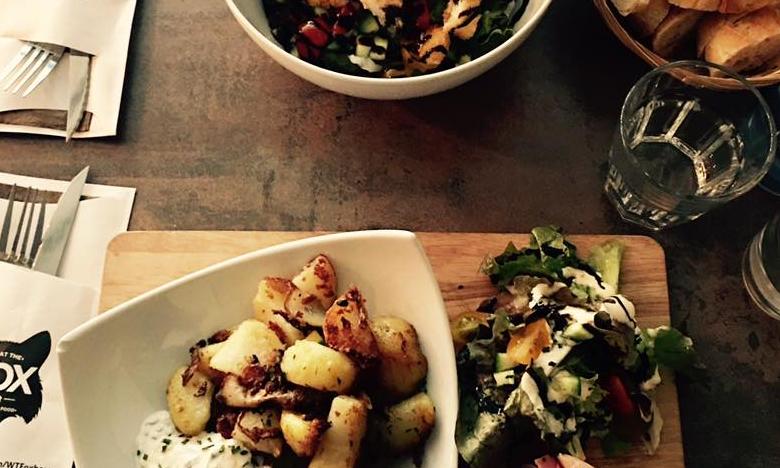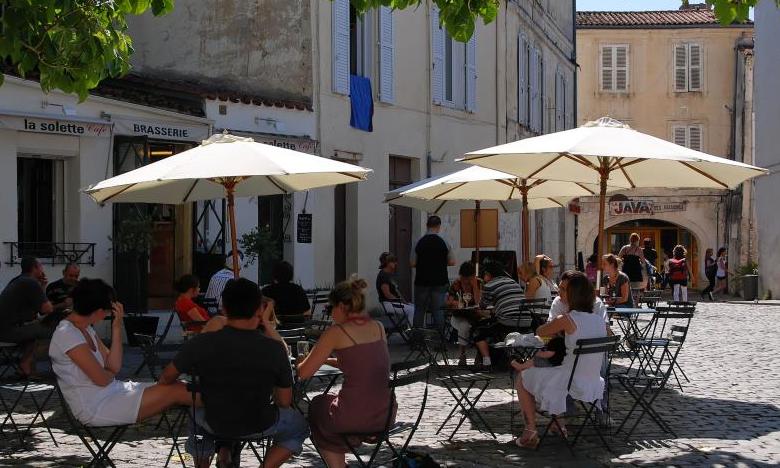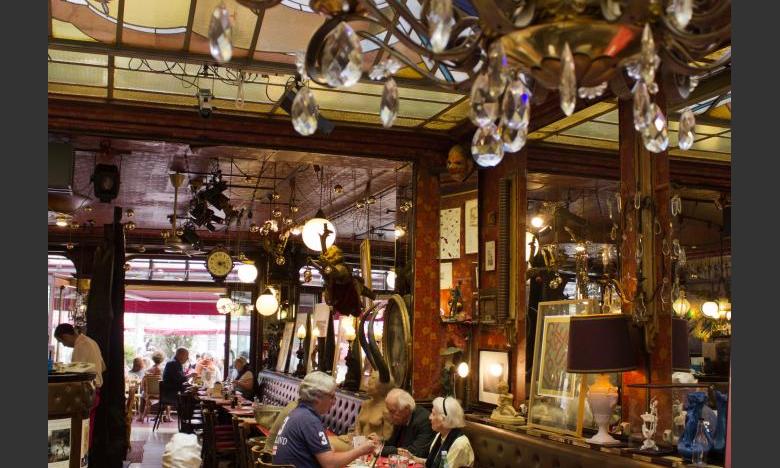Paris abounds with cafés, bistros, and fine cuisine of all kinds; yet some things are best savored en région. Take sauerkraut in Alsace, for instance, or oysters on the coast. It’s hard to beat the authenticity. Luckily, a number of cities with delectable local specialties and notable chefs are less than two hours by train from the capital by TGV, or high-speed train. Pack your weekender or just go for the day and hop on the next train for a culinary adventure.
STRASBOURG
Take a morning train from Paris and you could be having some tasty, German-influenced fare for lunch. Pork-filled sauerkraut is perfect for winter months, especially when accompanied by some of the local Gewürztraminer. Try a Flammekueche, which literally translates to “flambéed pie,” for something slightly lighter.
Alsace is also known for its succulent foie gras, which you can try at Les Haras Brasserie, Strasbourg’s former national stud farm just a ten-minute walk from the city center. Les Haras was home to some of the country’s finest horses from the mid-18th century to 2005, and has been an award-winning restaurant and hotel since 2013.
Three Michelin-starred chef Marc Haeberlin runs the kitchen, serving up regional classics alongside worldly inspired dishes, using local, seasonal products. The venue’s clean, original design is also impressive, as is the selection of whiskeys and rums in the lounge downstairs.
BORDEAUX
The city has been attracting foodies for decades, maybe even more so now that some of the world’s greatest chefs are calling it home. In autumn 2015, Gordon Ramsay took over Le Pressoir d’Argent, a classic venue in the five-star Grand Hôtel and Spa Bordeaux. He entrusted his kitchen to Gilad Peled, who managed to earn a Michelin star after just two months of operation. This place defines friendly fine dining, and counts native lobster and Aquitaine veal among its signature dishes.
Quatrième Mur is also located in one of Bordeaux’s most beautiful buildings, the National Opera House, at Place de la Comédie in the heart of the city. It is run by acclaimed chef and famous television personality, Philippe Etchebest, whose small, seasonal menu changes regularly, employing only the freshest ingredients to create visually stunning dishes.
For a vineyard experience like no other, head to Bernard Magrez’s Grande Maison, a five-star estate where wine, haute cuisine, and the arts together create the quintessential Bordeaux experience. The restaurant, run by Pierre Gagnaire, uses only local, mostly organic ingredients, while the Château itself offers tasting courses, guided tours, and wine blending workshops.
DIJON
One of Dijon’s best restaurants can be found in the four-star boutique hotel, Hostellerie du Chapeau Rouge, and is run by two-starred Michelin chef, William Frachot. Minimalistic, cozy and peaceful, the setting here is the ultimate backdrop to savor Frachot’s refined seven-course signature tasting menu. The in-house sommelier, renowned for his selection of Burgundy favorites, is always happy to provide insight on food and wine pairing.
Michelin-starred pastry chef and chocolatier, Thierry Marx, known as the pioneer of molecular gastronomy, has been busy making cuisine accessible to all. He recently opened his seventh Cuisine Mode d’Emploi(s) in Dijon, an establishment that offers free cooking, baking, and restaurant courses for the unemployed and those with difficulty integrating the workplace. This initiative, which has trained some 250 people a year for the past five years, has seen a great success rate.
LA ROCHELLE
The streets of this little-known foodie destination on the Atlantic are lined with seafood restaurants, cafés and bistros, and if you like oysters, this is the place for you.
Europe’s largest production and France’s only Red Label oyster, the Marennes-Oléron, come from just a few miles away, from the basins around Oléron Island. There are also many mussel farms nearby, so do try an éclade de moules if you happen to see it on the menu.
The city’s main market, Marché des Halles, opens every morning, until 1pm, and oozes with cheeses, patés, fresh breads and fruit, which you can enjoy quayside when it’s sunny. Or indulge in a decadent early lunch, with a dozen oysters at the bar and a glass or two of chilled Entre-Deux-Mers. Don’t forget to pick up a bag of local sea salt caramel for the train ride back to Paris.
Visit La Rochelle at a glance.
REIMS
Reims is just one hour from Paris by TGV, and L’Assiette Champenoise, in Tinqueux, is well worth the trip. This family operation is run by three-Michelin-starred chef Arnaud Lallement, whose parents started the business some 40 years ago. Now a five-star Relais & Châteaux property, the dining room’s contemporary design is the perfect setting to sample delicate signature dishes, like the blue lobster, a nod to the chef’s father. The impressive wine cellars contain some 3,000 bottles.
And of course, when in Reims, drink Champagne. It’s served in all the finest restaurants, but also in the trendy Champagne bars popping up around the city. Connoisseurs and novices alike can opt for one of the many Champagne tours available around the city itself or just outside, in the vineyards. Don’t leave the city without tasting its famous pink delicacy, le biscuit rose de Reims. Maison Fossier has been making these cookies for over 260 years now, and boasts crispy, double baked, sweet and savory collections that fit beautifully in your luggage. These also go undeniably well with a glass of bubbly.
LE HAVRE
Le Havre loves its coffee. Its long history with the brew was cemented in the mid-1700s, when shiploads of coffee, cacao, and cotton from the colonies began arriving to the port. Hundreds of thousands of bags of beans were traded here, and many of the surrounding warehouses were initially built to store coffee. Le Havre has been the bean’s main importer in France since the early 1800s, and still today plays an important role in its distribution throughout Europe.
Small, independent roasters and brewers are all throughout the city, and chances are you won’t get a cup of bad coffee in Le Havre. In fact, even great chefs like Jean-Luc Tartarin serve café that’s made produced 100% in Le Havre.
Chef Tartarin’s wife, Annabelle, welcomes guests in their eponymous restaurant located on one of the main streets rebuilt to Auguste Perret’s vision after WWII. The venue is calm and modern, and the menu, a poetic composition inspired by the surrounding sea. Ingredients are key here, procured daily from local gardens and small fishermen. Tartarin, who boasts two Michelin stars, is best known for his amuses-bouches and excellent sauces.
VERSAILLES
This noble city has France’s second largest market, and one of the oldest marketplaces, built during the reign of Louis XIII. Notre-Dame Market became a beautiful covered market under Louis XIV, and has since been the social hub of the city, offering everything you could possibly want from a French market, including fresh pastries and succulent escargots.
For a truly majestic experience, head to the Palace itself, to Ore by Alain Ducasse, an elegant, contemporary café accessible from Versailles’ Cour des Princes. The restaurant, divided into several sections each more sumptuous than the other, serves breakfast, lunch, and La Reine Marie’s afternoon tea. Continue your royal gastronomic tour with the acclaimed Gordon Ramsay at the Waldorf Astoria Trianon Palace, just steps away. Modeled after the Chef’s London restaurant, Ramsay au Trianon serves up inventive French cuisine in an intimate setting. In the summer, make sure to reserve your table at La Véranda.




